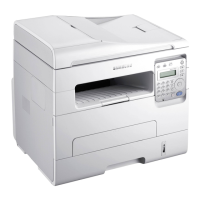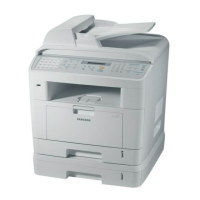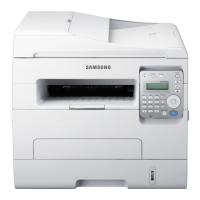Do you have a question about the Samsung SCX-4729FD and is the answer not in the manual?
General safety warnings for servicing the product by trained technicians.
Safety precautions for electric shock, fire hazards, and toxic materials.
Information on toxic materials within the product that could cause illness if ingested.
Detailed precautions against electric shock and fire hazards during operation and servicing.
Guidelines for safe handling of the product to avoid injury or damage.
Precautions to follow during product assembly and disassembly procedures.
Warnings about potential bodily injury from improper handling, like hot parts or moving components.
Precautions for handling Electrostatic Sensitive Devices (ESDs) to prevent damage.
Overview of the product's general specifications.
Detailed product specifications including speed, resolution, memory, and interface.
Detailed technical specifications for various printer functions like print engine and copier.
Specifications related to the print engine's performance, speed, and warm-up time.
Specifications detailing the copier function's speed, resolution, and paper handling.
Specifications detailing the scanner function's method, speed, resolution, and depth.
Specifications detailing the fax function's compatibility, speed, and features.
Details on the printer's controller, processor, memory, and supported operating systems.
Information on paper input capacities, types, sizes, and duplexing capabilities.
Details on toner cartridges, average yield, and part names.
Information on product reliability metrics like MPBF, MTTR, and life cycle.
Operating environment requirements, acoustic noise levels, and power consumption.
List of key maintenance parts, their part codes, and expected service life.
List of optional features available for the printer.
Comparison of specifications with similar printer models.
Overview of the printer's system components and architecture.
Identification of external components visible from the front of the printer.
Identification of external components visible from the rear of the printer.
Diagrams illustrating the paper path during simplex, duplex, and MP printing.
Diagram showing the internal layout of the printer's main components.
Details on the paper feeding mechanism, including cassette, rollers, and MP tray.
Description of the transfer roller's function and its lifespan.
Information on the components comprising the printer's drive unit.
Explanation of the fuser unit's components, heat/pressure function, and safety features.
Description of the LSU's function and related error signals.
Details on the toner cartridge, OPC unit, developing unit, and toner types.
Overview of the printer's electrical circuit system components and boards.
Details of the main processor (CPU) and its connections on the main board.
Information about the Operator Panel (OPE) board and its interface connections.
Details of the wireless LAN module and its interface for the SCX-4729FW.
Information on the fax controller board (FCON) and its components.
Description of the joint connection board for various components like clutches and fan.
Details of the Switching Mode Power Supply (SMPS) board, including specifications.
Information on the High Voltage Power Supply (HVPS) board and its functions.
Diagrams showing the location of sensors, motors, and clutches within the printer.
Explanation of the engine firmware control algorithms for various functions.
Control algorithm for the paper feeding process and jam detection logic.
Control algorithm for the transfer process, including voltage adjustments.
Control algorithm for the fusing process and management of heat-related errors.
Control algorithm for the LSU and related error detection and recovery.
Overview of the printer's software system architecture and components.
Description of the host software and firmware components.
Diagram illustrating the printer's software architecture.
Block diagram explaining data and control flow between host and firmware.
General precautions for replacing parts and handling PBAs safely.
Specific precautions for assembly and disassembly tasks, including screw usage.
Guidelines for handling Printed Circuit Boards (PCBs) safely, especially regarding static electricity.
Method for releasing plastic latches during disassembly to avoid breakage.
Table listing screws by part code, location, and quantity for disassembly.
General section for replacing main service parts.
Step-by-step instructions for removing the printer's front, rear, and side covers.
Procedure for removing the Operator Panel (OPE) unit and its connector.
Step-by-step guide for removing the scanner assembly and its covers.
Procedure for removing the Automatic Document Feeder (ADF) unit and its connectors.
Instructions for removing ADF rollers, including holders and E-rings.
Procedure for removing the ADF motor and its securing screws.
Instructions for removing the scan motor, including belt release.
Procedure for removing the Contact Image Sensor (CIS) unit and its flat cable.
Steps for removing the middle cover after disconnecting connectors.
Procedure for removing the fax board after disconnecting cables and covers.
Instructions for removing the main board after disconnecting connectors and brackets.
Procedure for removing the SMPS (power supply) board and its connectors.
Instructions for removing the HVPS board after disconnecting connectors and screws.
Procedure for removing the bin-full sensor after removing the main board.
Instructions for removing the main drive unit after moving FUSER SWING.
Procedure for removing the pick-up and registration clutches.
Instructions for removing pick-up and forward rollers.
Procedure for removing the retard roller and its holder.
Instructions for removing the duplex unit, including cover and handle operations.
Procedure for removing the transfer roller after opening the front cover.
Instructions for removing the LSU assembly after disconnecting cables and screws.
Procedure for removing the fuser unit after disconnecting connectors and screws.
Instructions for removing the exit sensor after removing the fuser unit.
Procedure for removing the feed and regi sensors.
Instructions for removing various motors, including fan and drive motors.
Procedures for aligning and adjusting printer components for optimal performance.
Explanation of the printer's control panel buttons and their functions.
Explanation of the status LED indicators and their meanings for machine status.
Procedures for removing paper jams from the document feeder.
Step-by-step guide for clearing jams in the document feeder.
Procedures for clearing paper jams in various locations within the printer.
Accessing useful menu items for monitoring supplies and performing maintenance.
Troubleshooting image defects that appear at regular intervals due to roller issues.
Using software tools like Samsung Easy Printer Manager for configuration.
Guide to using the Samsung Easy Printer Manager application for settings and monitoring.
Using the Samsung Printer Status program for monitoring machine status and errors.
Using the Smart Panel utility for Linux users to monitor and customize settings.
Instructions for updating the printer's firmware via USB or network.
Procedure for updating firmware via a USB connection.
Procedure for updating firmware over a network connection using SyncThru.
How to enter and use the machine's service (Tech) mode for testing.
General troubleshooting steps and procedures for diagnosing issues.
Diagnostic flowchart for checking printer symptoms and identifying causes.
A basic checklist for initial troubleshooting of common issues.
Table listing error codes, messages, and corresponding troubleshooting steps.
Troubleshooting common image quality issues like lines, spots, and density variations.
Troubleshooting for other common printer errors like multi-feeding and no-power.
Block diagram of the printer's electrical system and component interactions.
Detailed connection diagram showing how printer components are interconnected.
Recommended tools for performing troubleshooting on the printer.
Glossary of terms commonly used in the manual and related to printing technology.
Sample print pattern used for testing toner cartridge life and printing speed.
Guidelines for selecting a suitable and safe installation location for the printer.
| Dimensions (WxDxH) | 406 x 338 x 384 mm |
|---|---|
| Networking features | Fast Ethernet |
| All-in-one functions | Copy, Fax, Print, Scan |
| Color all-in-one functions | Scan |
| Compatible operating systems | Windows 2000 / XP / Vista / 7 / 2003 Server / 2008 Server Mac OS X 10.4 - 10.6 Linux OS |
| Print technology | Laser |
| Maximum resolution | 1200 x 1200 DPI |
| Economical printing | Yes |
| Time to first page (black, normal) | 8 s |
| Print speed (black, normal quality, A4/US Letter) | 28 ppm |
| Digital sender | No |
| Maximum duty cycle | 12000 pages per month |
| Number of print cartridges | 1 |
| Copier resize | 25 - 400 % |
| Maximum number of copies | 99 copies |
| Time to first copy (black, normal) | 14 s |
| Copy speed (black, normal quality, A4) | 28 cpm |
| Maximum scan resolution | 4800 x 4800 DPI |
| Faxing | Mono faxing |
| Fax memory | 600 pages |
| Modem speed | 33.6 Kbit/s |
| Total input capacity | 250 sheets |
| Total output capacity | 150 sheets |
| Auto document feeder (ADF) input capacity | 40 sheets |
| Envelopes sizes | 10, C6, DL |
| Maximum print size | 216 x 356 mm |
| Paper tray media types | Bond paper, Card stock, Envelopes, Labels, Plain paper, Pre-Printed, Recycled paper, Transparencies |
| Non-ISO print media sizes | Executive (184 x 267mm), Folio (media size), Legal (media size), Letter (media size), Oficio (media size) |
| ISO A-series sizes (A0...A9) | A4, A5, A6 |
| ISO B-series sizes (B0...B9) | B5 |
| Maximum ISO A-series paper size | A4 |
| Display | LCD |
| Market positioning | Home & office |
| Display number of lines | 2 lines |
| Direct printing | - |
| Standard interfaces | Ethernet, USB 2.0 |
| USB 2.0 ports quantity | USB 2.0 ports have a data transmission speed of 480 Mbps, and are backwards compatible with USB 1.1 ports. You can connect all kinds of peripheral devices to them. |
| Internal memory | 128 MB |
| Sound pressure level (copying) | 52 dB |
| Sound pressure level (printing) | 50 dB |
| Power consumption (average operating) | - W |
| Weight | 10300 g |
|---|












